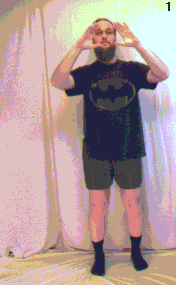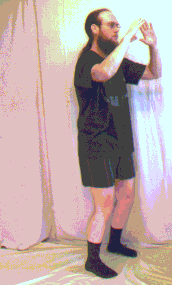|
Open a new browser window by clicking HERE
to take a look at great old photos of Li Li Da's Teacher, Master Wu Kung Yi, performing the Wu style of T'ai Chi Ch'uan! |
LESSON 3:
BRUSH
KNEE TWIST STEP (right)
WARD
OFF
BRUSH
KNEE TWIST STEP (right)
| please read the following text information while the images load on the page |
click>>>LESSON
1<<<here
click>>>PREVIOUS
LESSON - 2<<<here
click>>>NEXT
LESSON - 4<<<here
Letters in ( )*
stand for the eight directions=N, S, E, W, NW, NE, SW, SE.
Numbers in ( )*
correlate to the frame number in main lesson image below,
as much as possible...(some frames are 'in between' described movements,
in which case either I will try to redo the image, or you will need to
exercise
your imagination even more than is necessary to learn any movement art
from
'text and images' alone in the first place.)
Formula in brackets [W= ] denote weightedness,
which is the amount of body
weight shifted to either side (L=left, R=right, even=doubleweightedness);
example: [W=70R] means 'put 70% of your weight on your right
side.' The range
here will be approximate, ideally based on an individuals personal needs,
abilities and experience. *You
may choose to read through the text the first time disregarding these
parentheticals...it's easier!!
We OPENED
the set (Lesson 1) facing
North (N); as you view images on your monitor for the current postures
(below), imagine that you are again facing North as you begin the first
Brush knee twist step and as you end this lesson with the second Brush
knee twist step, you are facing West.
| Brush
knee twist step (right) Ward off Brush knee twist step (right) Brush knee twist step (right) (1 through 17) At the conclusion of white crane preening wings (1), you face North with knees slightly bent; arms up at shoulder level, your elbows point out to your sides, with your palms facing away, as if holding a small globe. Brush knee twist step begins as you pull your elbows slowly toward one another, drawing your hands slightly apart (2,3) until both your lower arms (the elbow joints to the hands) are parallel to one another and perpendicular to the floor, and your upper arms (the elbows to the shoulders) are parallel to one another and parallel to the floor (4).¹ As your arms straighten, your palms turn slowly to face each other, the elbows bending each arm at almost a 90° angle. [W= even] Bend your knees slightly (5) as you bow slightly forward at the waist and slowly begin to shift your weight to your right leg (6) [W= 60R]. Begin rotating your upper torso to the left as you continue shifting your weight [W= 70R] to the right side, and begin to lower your left hand, with your left palm facing in. [W= 80R] At the same time, lift your left toe only (7), and pivot on the left heel (8) until your left foot is pointing West, with the toe up. (9) [W= 90R] (Your feet now form at almost a full right angle; right foot flat, left toe up and your left hand has dropped halfway down in its descent. Remember to keep your behind tucked in.) As your upper torso finishes rotating left 90°, and your left hand continues its descent (10), your right palm (still facing West) pushes to your left (W) at shoulder level; this occurs as your center starts (11) shifting your weight [W= 80R] back to the left side. As you push to the left [W=70R], your body (from the tan tien, or center) dips very, very slightly² down and back up in an arc [W= 60R], and you lower your left toe down (11-14) [W= even]³. As the right palm, fingers up, pushes the imaginary opponent at the shoulder level (12-17), your left hand drops to a few inches in front of and above (14) [W= 70L] your left knee (hence the first part of the name for this posture, brush knee), with the left palm facing in toward the knee, while the right foot (with weight mostly on the heel, pivoting) twists (hence the second part of the name for this posture, twist step) to the NW corner, forming an acute angle with the left foot of about 30-45° (be comfortable) as the momentum forward (West) concludes. (17) [W= 80L] At that point, the left hand rests just outside of the left leg, palm facing backward, fingers down; the right palm faces away (West) in a "push" at about shoulder height, fingers to the ceiling; both elbows are slightly bent, and your left knee-cap is aligned directly above (but, in no case further out than) your left toe. Ward off (18 through 28) Next, slowly raise your left foot (18-21) onto its heel only again, forcing your weight (and you!) back (East) onto your right foot [W= 70L], while moving your left hand upward slowly to a position near your right hand. (18-23) The left hand rises in an arcing motion from your left side to slightly above where the right hand, which simply rotates the palm from West to South, is waiting. Both your hands rotate inward so that as they near each other, the palms are facing. As the left hand meets near (and just above) the right (24), the right fingertips graze the bottom of the left palm, with all of your fingers pointing to the ceiling. [W= even] Then rotate your waist 45° [W= 60R], back toward your right (24-28), carrying [W= 70R] both upper and lower torso as one until [W= 80R] you point to the (NW) corner (28); your hands retain their same position as you rotate as one. At the end of the Ward off posture, your energy is wound up quite like a baseball pitchers, who 'winds' (wards) (18-28) before the 'pitch' (push) (29-35). Brush
knee twist step (right) (29
through 35) (Remember to keep your knees and elbows at least slightly bent and your pelvis tucked in throughout the set.) (If at all possible, it is suggested that someone read the text to you - or record it on a tape and play it back - while you slowly practice the form...and slowly is the best way to practice.)
|
do not over-do do
not under-do
click>>>LESSON
1<<<here
click>>>PREVIOUS
LESSON - 2<<<here
click>>>NEXT
LESSON - 4<<<here
|
FUNDAMENTALS OF |
May I suggest the best way to see these
images in the days after
the lesson page has changed is to 'right click' on those images you want NOW
and click
'save image as', then save it to some hard drive (the loads are BIG!)
You can also freely copy/paste/amend the text. (But do not sell, please)
~ ~ special thanks
~ ~
to
Michael W and Shar'n
for making free cyberspace available for MORE Playshop lessons at
www.caliban.net
NOW all of the Playshop lessons should ALWAYS be available online
~ ~ ~
If the pictures stop animating on your page,
hit reload (refresh)
(I've even had to "clear memory
cache" first if I interrupted initial page loading)

follow my movement on your monitor
you will be performing a Right Hand Set...
(t'ai chi is practiced from both sides)
when YOU practice t'ai chi, move slowly
(and hopefully less jerkily than this animation)
Diagonal view of Brush knee twist step  |
click>>>LESSON
1<<<here
click>>>PREVIOUS
LESSON - 2<<<here
click>>>NEXT LESSON
- 4<<<here
~ ~ ~ ~
~
notes:
I made the T'ai Chi graphic images using a reverse image option so
that I could
video the Left Hand Set, then when it is viewed here on your monitor, it appears
as a mirror image of a Right Hand Set, which you can emulate by following
my movements. Most T'ai Chi students only learn the Right Hand Set,
and it is a good way to start. One can practice the opposite side movements
(Left Hand) by practicing the reverse of the image(s) above. I
am fortunate that the students who instructed me at my t'ai chi beginning
practiced both sides of the set daily. By learning the left and right
versions (identical, just reversed) of t'ai chi, I believe one may gain even
more.
~ ~ ~ ~
~
more notes:
Please
let me know what you like here and what really bugs you here, too
TO EMAIL HERE PLEASE MANUALLY CHANGE 'AT'
TO '@'
Is there some aspect of the movement not made clear by the images
(or the text, for that matter)?? Please tell me, and if I cannot clarify
it with words I will try to make a new image to illustrate a way out
of that confusion.
~ ~ ~
~ ~
still more notes:
It is better by far to experience learning Tai Chi of any kind
in a group setting, primarily for two reasons. First, it's more fun! and
nothing is better for learning than sharing ideas and practice with individuals
who share the same interests. By having many artisans practice together,
this allows for an excellent source of useful feedback. More than
critically watching the moves as others do them, this also affords an opportunity
that is unparalleled: by standing in the center surrounded by more advanced
students, with every movement in every direction, the novice has a rotating
view of the form. This allows the newer student to follow all the
others, even as the plane of movement tangents onto a new direction. Turn
left, a senior student is in front to follow from; turn right, another teacher
is in view;
spin around 180° and, yep, you guessed
it.
Though learning Tai Chi from pictures, and (sometimes even worse) from text,
is not the best method to use...it is what I can offer. Some people
have little or no access to teachers or classes in their area; some have
little or no money for them even if they did exist; some folk are shy and
some may be to dis-eased to go to a class; it is for all these people (the
ones online, at least) and of course for the martial arts intellectuals
(you know who you are) that I make this meager presentation.
For anyone in or near (or just visiting) the
San Francisco Bay Area, please accept our invitation to join us in our VIRTUAL REALITY
PLAYSHOP
(real people), any Saturday morning from 8:45 a.m. to 9:45 a.m.
at 1819 10th Street, in Berkeley.
(The set usually begins @ 9:10 a.m. Saturday
Just take the outside stairs on the south side of Finnish Hall to the top
to get in--or take the disabled folks elevator inside--if you need it)
~ ~ ~
~ ~
finally! feedback
finally, your notes:
Scott, I HAVE FEEDBACK FOR YOU
and/or
I wanna get email when the lesson page changes :)
FEEDBACK FORM:
last updated on Monday, July 19, 2010 at 9:03 P.M. P.S.T.
COPYWRONG © 1997-2010 swrichie ALL RIGHTS REVERSED
 copywrong
© 1998-2010 by
copywrong
© 1998-2010 by![]() swrichie for hand use creations
swrichie for hand use creations
![]()
ALL RIGHTS REVERSED
~ ~ ~ ~ ~
| we share some common strand in this universe...we | as one |